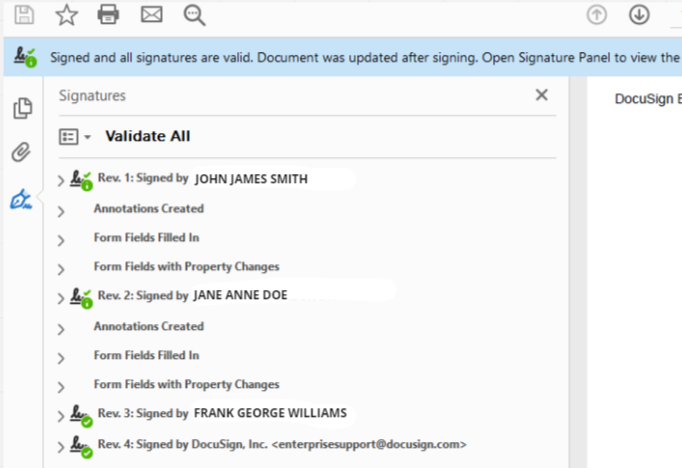How do I know if my document has been signed by QES?
If your document has been signed correctly by a QES, you should see a signature panel similar to the below confirming who has signed the document.

How will the QES signature be captured on the digital extract
Any visual representation of the QES used on the face of the deed will be retained as part of the extract. An additional page will also be included at the rear of each extract, setting out QES information (such as date of signing) not apparent from the face of the deed.
Do I need to identify capacity of a signatory in the document e.g. Director, secretary, authorised signatory details when signing with QES?
While there is no statutory requirement to provide capacity on the face of a QES signed deed, and we cannot therefore insist on this information being provided, in order for the document to be ex facie valid, the capacity of the signatory (e.g. Director, secretary, authorised signatory) should be evident from the face of the QES signed deed. We will assume that the party signing actually holds the correct capacity to do so. It will be a matter for the individual preference of customers whether they choose to carry out any further checks (e.g. at Companies House) to establish that the signatory in fact holds the correct capacity.
Will the QES signature cover all pages required to be signed e.g. colour plans, pictures etc.?
Yes. The rules on execution of electronic documents differ from those that apply to traditional paper documents and can be found in Part 3 of the Requirements of Writing (Scotland) Act 1995 and the Electronic Documents (Scotland) Regulations 2014.
The main difference is that qualified electronic signatures are applied to the document as a whole, rather than to the body of the deed and any subsequent annexations. As such, annexations are regarded as incorporated into a deed if they are (a) referred to in the deed, (b) identified on their face as being the annexation referred to in the document, and (c) annexed to the document before a QES is applied to the document and annexation.
Do I need a witness for the QES?
No. The ‘qualified’ aspect of the QES replaces witnessing as the requirement for self-proving status in electronic documents.
Can I sign QES documents in counterpart, and do all counterparts need to be electronic documents?
Yes, it is possible to use counterpart execution both where all counterparts are electronic documents, and where there is a mix of paper and electronic counterparts (see question 6 for further information).
Who will validate deeds signed with QES once submitted by the customer?
Registers of Scotland will check all QES’s used in deeds submitted to us to ensure that they are both valid and comply with the requirements of the Requirements of Writing (Scotland) Act 1995 and the Electronic Documents (Scotland) Regulations 2014 (this is broadly equivalent to the checks we currently do on wet signatures).
